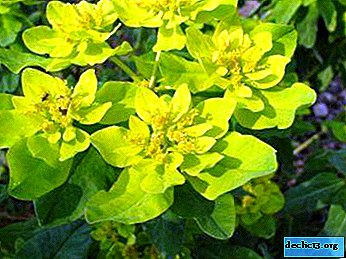A plant of amazing appearance - euphorbia multiflorum: its characteristic and photo

Euphorbia is an amazing and unusual plant that has been loved by many gardeners because of the simplicity of cultivation, unpretentiousness in maintenance and care.
The variety of species and the brightness of colors during the flowering period will not leave indifferent neither experienced gardeners, nor amateur beginners.
Plants of the family Euphorbia unites the ability to accumulate moisture in the intercellular tissue and keep it inside, thus compensating for the lack of watering the soil. Learn more about Milkweed in our article.
Botanical Description
Reference! Euphorbia multicolor or multiflorum (Euphorbia polychroma) is common in Europe, Russia, Ukraine, Asia and Africa. The plant is able to take root in rocky terrain, on hillsides, in places with calcareous soil.- The plant is a bush, reaching a height of not more than 70 centimeters. Of the many species of milkweed, the Euphorbia polychroma species is deservedly considered not only one of the most beautiful, but also the most frost-resistant. This perennial herb plant perfectly survives in gardens and alpine lawns.
- The main decoration of milkweed is not flowers, but stipules, which form the basis of the flower. During the flowering period, which lasts from May to July, stipules are located under inflorescences and are filled with bright colors. The color scheme includes all shades of green: from bright lemon to dark green. Golden leaves and inflorescences crown each shoot until late autumn.
- All types of milkweed contain milky juice, which is their main difference from other plants. Juice is an intercellular fluid containing toxic substances. When caring for milk, the following precautions should be observed: protect hands with gloves, do not allow juice to enter the stomach and mucous membranes of the nose and eyes.
Photo
In the photo you can see how the euphorbia multiflorum looks:




Care Rules
This species is one of the most popular and favorite species among landscape designers. In addition to decorative spherical bushes, it is frost-resistant and does not require special skills in maintaining the plant. Euphorbia is a perennial plant and so that it delights with its colors from early spring to late autumn for many years, you should adhere to simple rules of care.
- All types of milkweed that are planted in open ground feel best in open sunny areas. This plant is one of those who love the sun. Planting it in the shade, you will not be able to get an amazing and luxurious bush.
Euphorbia multiflorum is a photophilous plant, if planted in the shade, it will bloom and develop worse.
- Euphorbia tolerates dry and hot weather, but drying out the soil should not be allowed. Watering should be regular, especially in drought. When planting seedlings in a hole, it is advisable to place expanded clay, since in rainy weather the water must leave without stagnating around the roots.
Important! Overmoistening of the soil should not be allowed, since the root system of milk of multi-color will begin to rot and the plant will die.
- Euphorbia perfectly tolerates wintering in open ground and does not need shelter. At the end of October, when the plant drops its leaves, the bare shoots should be cut. In spring, cut dried leaves and branches.
- Euphorbia is a succulent plant; during the growing season, it is advisable to feed fertilizers for cacti twice a month.
- If the plant is grown in a pot, then the capacity should be chosen wide and shallow.
With proper planting, care and suitable conditions, a multi-color milkweed bush will grow 7-9 years.
Breeding methods
Euphorbia can be propagated in three ways: cuttings, seeds, and division.
 The most effective way to propagate euphorbia will be the division of the finished bush. To do this, a widely grown bush is divided into several parts and planted in different holes with a depth of 15 cm.The plant is well established and grows quickly, so the distance between the bushes should be at least 50 cm. It is better to divide the bush in April.
The most effective way to propagate euphorbia will be the division of the finished bush. To do this, a widely grown bush is divided into several parts and planted in different holes with a depth of 15 cm.The plant is well established and grows quickly, so the distance between the bushes should be at least 50 cm. It is better to divide the bush in April.- Euphorbia is a dioecious plant, but it is possible to distinguish between male and female plants only during the flowering period. Seeds are planted in open ground in the fall in a shallow hole. The landing site must be covered with sawdust mixed with humus. When growing plants from seeds in the spring, seedlings will appear after 15 days. The disadvantage is the long time between planting and the beginning of flowering.
- It is very convenient to breed euphorbia by the method of cuttings. The most suitable time is the beginning of June. It is necessary to select young juicy shoots and cut them with a sharp knife, then rinse the milky juice with warm water. The mother bush also must be cleaned at the place of the cut. Dry the prepared cuttings for two days, and then plant them in boxes or in open ground. Waterlogging of the soil must not be allowed, otherwise the plants will die. Rooting occurs after one month. To strengthen the root system, you can treat the cuttings with the drug "Kornevin."
Diseases and Pests
Euphorbia is a survivable and disease-resistant plant. It is the milky juice, which includes toxic substances, that protect the flower from pests.
- If the plant does not bloom, discard leaves or become a sickly yellow color - the reason for everything can be improper care. For a healthy existence, milkweed requires a lot of light, moderate soil moisture and open space.
- Occasionally, parasite damage occurs: whiteflies, scutes, or spider mites. To protect the flower, it should be treated with a herbicide.
Euphorbia has found its application in landscape design, namely in the design of gardens and lawns. The plant affects a variety of shapes and sizes. Euphorbia multicolor harmoniously complements any composition with an unusual spherical shape of a bush. Due to the variety of forms and aesthetic appearance, spurge has become a popular flower in gardens, on personal plots on the windowsills of apartments and offices.

 The most effective way to propagate euphorbia will be the division of the finished bush. To do this, a widely grown bush is divided into several parts and planted in different holes with a depth of 15 cm.The plant is well established and grows quickly, so the distance between the bushes should be at least 50 cm. It is better to divide the bush in April.
The most effective way to propagate euphorbia will be the division of the finished bush. To do this, a widely grown bush is divided into several parts and planted in different holes with a depth of 15 cm.The plant is well established and grows quickly, so the distance between the bushes should be at least 50 cm. It is better to divide the bush in April.















